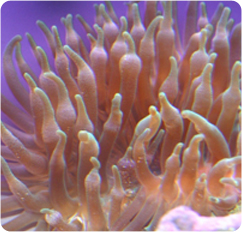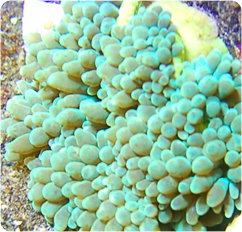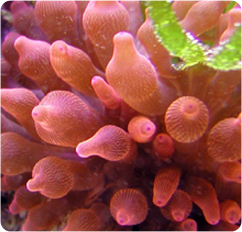|
Entacmaea quadricolor
Bubble Tip Anemones  Anemones are corals—sometimes people forget that point. It follows that, like most corals, anemones require special conditions in order to thrive. If you possess a mature tropical saltwater aquarium (more than six months old) with stable and excellent water quality and compatible animals, then keeping one or more anemones can be a tremendously rewarding experience on par with the best of the marine aquarium hobby. Anemones are corals—sometimes people forget that point. It follows that, like most corals, anemones require special conditions in order to thrive. If you possess a mature tropical saltwater aquarium (more than six months old) with stable and excellent water quality and compatible animals, then keeping one or more anemones can be a tremendously rewarding experience on par with the best of the marine aquarium hobby.
Of all the anemones commonly available in the hobby, the bubble tip anemone (Entacmaea quadricolor), sometimes commonly called a BTA, is truly the best suited for most aquarium situations and most aquarists. If provided with the appropriate environment, these anemones can even be considered hardy. Because anemones are a type of coral, the aquarist can think of the right environment for most anemones as reef-type in terms of water quality and stability. In addition to a stable environment with high water quality, BTAs need an aquarium with live rock and appropriate lighting, but more on that in a bit.
The bubble tip anemone is a hexacoral, a subclass of anthozans from the phylum cnidaria. Other hexacorals include zoanthids (order Zoanthidia), mushrooms (order corallimorpharia) and stony corals (order scleractinia). BTAs range throughout the Indo-Pacific and occur in a variety of colors from green and brown to red. The color variations found amongst individuals within the species may be based in part on geography but also on depth and the “mood” of the given specimen.
 The bubble tip anemone gets its common name from its namesake bubble tips, but not all BTAs have the same degree of bulbousness, and the degree to which a given specimen exhibits its bubble tips changes based on many factors including, but not limited to, light, flow, hosting animals, feeding, competition with other cnidarians. The bubble tip anemone gets its common name from its namesake bubble tips, but not all BTAs have the same degree of bulbousness, and the degree to which a given specimen exhibits its bubble tips changes based on many factors including, but not limited to, light, flow, hosting animals, feeding, competition with other cnidarians.
A happy bubble tip anemone will not move around the aquarium once settled. In the event that a BTA goes on a proverbial walk-about, the aquarist should immediately look for the root of the problem. Changes in system stability, lighting or tankmates may all be the culprit. Resolve the root problem, and the BTA should settle down.
 Many aquarists get an anemone because they want to keep it with a clownfish or a pair of clownfish. While neither the anemone nor the clownfish need each other in captivity, keeping them together in a marine aquarium is truly one of the more interesting symbiotic relationships that can be readily observed. In the wild, the BTA will host with at least 13 different clownfish species. In captivity, there are examples of nearly every clownfish hosting in a BTA, which is not to say that every clownfish will host in an anemone in captivity. Many aquarists get an anemone because they want to keep it with a clownfish or a pair of clownfish. While neither the anemone nor the clownfish need each other in captivity, keeping them together in a marine aquarium is truly one of the more interesting symbiotic relationships that can be readily observed. In the wild, the BTA will host with at least 13 different clownfish species. In captivity, there are examples of nearly every clownfish hosting in a BTA, which is not to say that every clownfish will host in an anemone in captivity.
While clownfishes pose no real threat to anemones after the initial introduction (a new clownfish can be rough on an established anemone and requires close monitoring), there are many other animals which can pose a very really threat to an BTA.
Many popular aquarium fishes such as triggerfishes, pufferfishes and angelfishes will harass and even kill anemones. In some cases, a clownfish hosting in an anemone will protect the anemone, but the aquarist who chooses to mix any of these fishes with anemones must keep a sharp eye out for any problems.
|